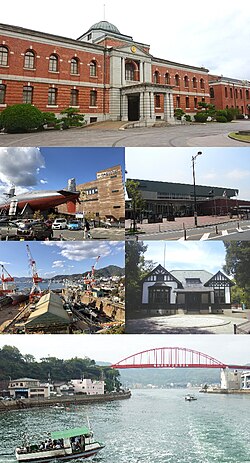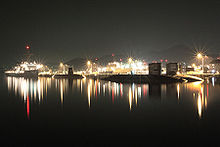| Kure 呉市 | |||||||||
|---|---|---|---|---|---|---|---|---|---|
| Core city | |||||||||

| |||||||||
 Flag Flag Seal Seal | |||||||||
| Location of Kure in Hiroshima Prefecture | |||||||||
 | |||||||||
 | |||||||||
| Coordinates: 34°14′57″N 132°33′57″E / 34.24917°N 132.56583°E / 34.24917; 132.56583 | |||||||||
| Country | Japan | ||||||||
| Region | Chūgoku (Sanyō) | ||||||||
| Prefecture | Hiroshima | ||||||||
| Government | |||||||||
| • Mayor | Yoshiake Shinhara (from November, 2017) | ||||||||
| Area | |||||||||
| • Total | 352.80 km (136.22 sq mi) | ||||||||
| Population | |||||||||
| • Total | 208,024 | ||||||||
| • Density | 590/km (1,500/sq mi) | ||||||||
| Time zone | UTC+09:00 (JST) | ||||||||
| City hall address | 4-1-6 Chūō, Kure-shi, Hiroshima-ken 737-8501 | ||||||||
| Climate | Cfa | ||||||||
| Website | Official website | ||||||||
| Symbols | |||||||||
| Flower | Camellia | ||||||||
| Tree | Oak | ||||||||
Kure (呉市, Kure-shi) is a city in Hiroshima Prefecture, Japan. As of 30 April 2023, the city had an estimated population of 208,024 in 106,616 households and a population density of 590 persons per km. The total area of the city is 352.80 square kilometres (136.22 sq mi). With a strong industrial and naval heritage, Kure hosts the second-oldest naval dockyard in Japan and remains an important base for the Japan Maritime Self-Defence Force.
History
The area of Kure is part of ancient Aki Province, and the port of Kure was an important seaport for Hiroshima Domain in the Edo period.
The Kure Naval District was first established in 1889, leading to the construction of the Kure Naval Arsenal and the rapid growth of steel production and shipbuilding in the city. Kure was formally incorporated on October 1, 1902. From 1889 until the end of the Pacific War, the city served as the headquarters of the Kure Naval District.
Kure dockyards recorded a number of significant engineering firsts including the launching of the first major domestically built capital ship, the battlecruiser Tsukuba (1905) and the launching of the largest battleship ever built, the Yamato (1940).
During the Pacific War, Kure acted as the Imperial Japanese Navy's single-largest naval base and arsenal. Most of the city's industry and workforce were employed in the service of the naval installations, munitions factories and associated support functions. In the later stages of the conflict Kure came under sustained aerial bombardment culminating in the bombing of Kure in June and July 1945.
From February 1946 until the end of Japan's postwar occupation in 1952, military establishments in Kure served as the operational headquarters for the British Commonwealth Occupation Force.
Since 2005, Kure has attracted attention as a tourism center with the Yamato Museum hosting a 1:10 scale model of the Yamato alongside a waterfront JMSDF museum of Japanese naval history.
The city continues as a major maritime center hosting both the dockyards of Japan Marine United and numerous shore-based facilities of the JMSDF including training centers and a major hospital. The city serves as the home port of an Escort Flotilla (Destroyers), a Submarine Flotilla and the Training Squadron of the JMSDF Regional Kure District.
Historic timeline
- July 1, 1889 — Kure Naval District established.
- 1895 — Kure naval shipyard established, initially as a subsidiary of the Onohama Shipyards in Kobe.
- October 1, 1902 — The towns of Washō and Futagawa and the villages of Miyahara and Sōyamada merge to form the city of Kure.
- November 10, 1903 — Kure Naval Arsenal established.
- December 27, 1903 Kure rail line opens providing direct rail access to Hiroshima
- April 1, 1928 — The towns of Kegoya, Yoshiura, and Aga merge into Kure.
- April 21, 1941 — The town of Nigata and the village of Hiro incorporated into Kure.
- March 19, 1945 — US Navy aircraft attack Japanese warships at Kure
- May 5, 1945 — Bombing of Hiro Naval Arsenal.
- June 22, 1945 — Bombing of Kure Naval Arsenal.
- July 1, 1945 — Kure Air Raid.
- July 24–28, 1945 — Battle of Kure, American bombers attack the remaining fleet in Kure Naval Base.
- July 1, 1954 — Japan Maritime Self Defense Forces founded.
- October 1, 1956 — The town of Tennō and the village of Shōwa in Aki District, and the village of Gōhara in Kamo District merge into Kure.
- November 1, 2000 — Kure becomes a Special City
- April 1, 2003 — The town of Shimokamagari (from Aki District) was merged into Kure.
- April 1, 2004 —The town of Kawajiri (from Toyota District) was merged into Kure.
- March 20, 2005 — The towns of Ondo, Kurahashi and Kamagari (all from Aki District), and the towns of Yasuura, Toyohama and Yutaka (all from Toyota District) were merged into Kure.
- April 1, 2016 — Kure officially became a Core city with increased local autonomy
Government
Kure has a mayor-council form of government with a directly elected mayor and a unicameral city council of 31 members. Kure contributes five members to the Hiroshima Prefectural Assembly. In terms of national politics, the city is part of the Hiroshima 5th district of the lower house of the Diet of Japan.
List of mayors of Kure (from 1903 to present)
| # | Name | Term start | Term end | Japanese name |
|---|---|---|---|---|
| 1 | Giichiro Sakuma | 4 February 1903 | 8 June 1903 | 佐久間義一郎 |
| 2-3 | Kingo Arao | 27 August 1903 | 28 August 1911 | 荒尾金吾 |
| 4-5 | Toshio Sawahara | 28 November 1911 | 6 July 1917 | 沢原俊雄 |
| 6 | Kentaro Amano | 17 August 1917 | 16 August 1921 | 天野健太郎 |
| 7 | Kahei Shundo | 2 February 1922 | 16 June 1925 | 春藤嘉平 |
| 8 | Masaharu Hashimoto | 24 April 1925 | 11 March 1927 | 橋本正治 |
| 9 | Toichi Katsuta | 13 June 1927 | 25 November 1930 | 勝田登一 |
| 10 | Hideo Sasaki | 25 November 1930 | 21 December 1932 | 佐々木英雄 |
| 11 | Atsumu Watanabe | 26 December 1932 | 12 May 1935 | 渡辺伍 |
| 12 | Katsutaro Matsumoto | 13 June 1935 | 1 September 1936 | 松本勝太郎 |
| 12-13, 15 | Jinjiro Mizuno | 4 May 1937 14 January 1946 |
13 December 1941 15 November 1946 |
水野甚次郎 |
| 14 | Noboru Suzuki | 11 June 1942 | 10 January 1946 | 鈴木登 |
| 17-18 | Jyutsu Suzuki | 5 April 1947 | 21 March 1954 | 鈴木術 |
| 19-20 | Kenichi Matsumoto | 18 April 1954 | 31 October 1961 | 松本賢一 |
| 21-24 | Yoshito Okuhara | 19 November 1961 | 18 November 1977 | 奥原義人 |
| 25-28 | Ari Sasaki | 19 November 1977 | 18 November 1993 | 佐々木有 |
| 29-31 | Shinya Ogasawara | 19 November 1993 | 18 November 2005 | 小笠原臣也 |
| 32-34 | Kazutoshi Komura | 19 November 2005 | 18 November 2017 | 小村和年 |
| 35 | Yoshiake Shinhara | 19 November 2017 | Present | 新原芳明 |
Geography





Kure is located 20 kilometres (10 mi) south-east of Hiroshima city and faces the Seto Inland Sea. Surrounded by steep hillsides to the north, the two major commercial and industrial centers of the city are bisected by Mount Yasumi 497 m (1,631 ft). The city is next to the Setonaikai National Park. As well as densely populated urban and industrial centers, the city also incorporates sparsely inhabited outlying islands such as Kurahashi-jima, Shimo-kamagari, Kami-kamagari and Toyoshima.
Adjoining municipalities
Demographics
Per Japanese census data, the population of Kure has been declining for the past 40 years.
| Year | Pop. | ±% |
|---|---|---|
| 1940 | 355,297 | — |
| 1950 | 292,769 | −17.6% |
| 1960 | 291,887 | −0.3% |
| 1970 | 306,222 | +4.9% |
| 1980 | 302,766 | −1.1% |
| 1990 | 280,429 | −7.4% |
| 2000 | 259,224 | −7.6% |
| 2010 | 239,553 | −7.6% |
| Kure population statistics | ||
Climate
Kure has a humid subtropical climate (Köppen climate classification Cfa) with hot summers and cool winters. Precipitation is significant throughout the year and is heaviest in summer.
| Climate data for Kure (1991−2020 normals, extremes 1894−present) | |||||||||||||
|---|---|---|---|---|---|---|---|---|---|---|---|---|---|
| Month | Jan | Feb | Mar | Apr | May | Jun | Jul | Aug | Sep | Oct | Nov | Dec | Year |
| Record high °C (°F) | 19.0 (66.2) |
21.5 (70.7) |
23.8 (74.8) |
28.1 (82.6) |
30.7 (87.3) |
33.7 (92.7) |
36.9 (98.4) |
37.8 (100.0) |
36.1 (97.0) |
31.1 (88.0) |
26.3 (79.3) |
22.7 (72.9) |
37.8 (100.0) |
| Mean daily maximum °C (°F) | 9.5 (49.1) |
10.2 (50.4) |
13.6 (56.5) |
18.7 (65.7) |
23.3 (73.9) |
26.1 (79.0) |
29.9 (85.8) |
31.5 (88.7) |
28.1 (82.6) |
22.9 (73.2) |
17.3 (63.1) |
11.9 (53.4) |
20.3 (68.5) |
| Daily mean °C (°F) | 6.1 (43.0) |
6.5 (43.7) |
9.6 (49.3) |
14.4 (57.9) |
19.0 (66.2) |
22.4 (72.3) |
26.5 (79.7) |
27.9 (82.2) |
24.5 (76.1) |
19.2 (66.6) |
13.6 (56.5) |
8.4 (47.1) |
16.5 (61.7) |
| Mean daily minimum °C (°F) | 2.8 (37.0) |
3.0 (37.4) |
5.7 (42.3) |
10.4 (50.7) |
15.2 (59.4) |
19.4 (66.9) |
23.8 (74.8) |
25.0 (77.0) |
21.5 (70.7) |
15.8 (60.4) |
10.0 (50.0) |
5.0 (41.0) |
13.1 (55.6) |
| Record low °C (°F) | −5.4 (22.3) |
−7.1 (19.2) |
−4.9 (23.2) |
−0.5 (31.1) |
4.7 (40.5) |
10.1 (50.2) |
14.8 (58.6) |
16.4 (61.5) |
9.7 (49.5) |
4.4 (39.9) |
0.0 (32.0) |
−5.5 (22.1) |
−7.1 (19.2) |
| Average precipitation mm (inches) | 41.5 (1.63) |
59.3 (2.33) |
106.7 (4.20) |
126.0 (4.96) |
147.2 (5.80) |
217.9 (8.58) |
251.4 (9.90) |
113.2 (4.46) |
143.7 (5.66) |
97.2 (3.83) |
65.1 (2.56) |
48.3 (1.90) |
1,417.2 (55.80) |
| Average snowfall cm (inches) | 1 (0.4) |
2 (0.8) |
trace | 0 (0) |
0 (0) |
0 (0) |
0 (0) |
0 (0) |
0 (0) |
0 (0) |
0 (0) |
0 (0) |
3 (1.2) |
| Average precipitation days (≥ 1.0 mm) | 4.7 | 6.5 | 8.8 | 9.0 | 8.6 | 10.6 | 9.6 | 6.5 | 8.1 | 6.4 | 5.8 | 5.3 | 89.9 |
| Average snowy days (≥ 1 cm) | 0.3 | 0.7 | 0.1 | 0 | 0 | 0 | 0 | 0 | 0 | 0 | 0 | 0 | 1.1 |
| Average relative humidity (%) | 63 | 63 | 63 | 63 | 67 | 75 | 76 | 73 | 70 | 66 | 66 | 65 | 68 |
| Mean monthly sunshine hours | 140.7 | 145.7 | 181.7 | 194.8 | 212.3 | 155.9 | 183.9 | 217.9 | 166.8 | 176.0 | 150.5 | 141.6 | 2,067.9 |
| Source: Japan Meteorological Agency | |||||||||||||
Economy
- Disco Corporation has three manufacturing plants in Kure
- Japan Marine United, formerly IHI Marine United, has a shipyard in the city
- Mitsubishi Hitachi Power Systems
- Mitutoyo
- Nisshin Steel
- Oji Paper Company
- Sailor Pen Company
- Yodogawa Steel Works
Education
Colleges and Universities
- Goko Academy
- Japan Coast Guard Academy
- Kure Kyosai Hospital Nursing College
- Kure University
- National Institute of Technology, Kure College
Primary and secondary education
Kure has 37 public elementary schools, 25 public junior high schools and one public high school operated by the city government, and seven public high school operated by the Hiroshima Prefectural Board of Education. There are also one private middle school and three price high schools. The prefecture also operates two special education schools for the disabled.
Transportation

Railway
[REDACTED] JR West (JR West) - Kure Line
- Yasuura - Ato - Akikawajiri - Nigata - Hiro - Shin-Hiro - Akiaga - Kure - Kawaraishi - Yoshiura - Karugahama - Tennō - Kure-Portopia
Highways
 Higashihiroshima-Kure Expressway
Higashihiroshima-Kure Expressway Hiroshima-Kure Road
Hiroshima-Kure Road National Route 31
National Route 31 National Route 185
National Route 185 National Route 375
National Route 375 National Route 487
National Route 487
Sister cities
As of September 2017, Kure has sister city agreements with the following cities.
Sister cities
 Bremerton, Washington, United States (since August 1970)
Bremerton, Washington, United States (since August 1970) Marbella, Andalusia, Spain (since December 1990)
Marbella, Andalusia, Spain (since December 1990) Jinhae-gu, Changwon, South Gyeongsang, South Korea (since October 1999)
Jinhae-gu, Changwon, South Gyeongsang, South Korea (since October 1999) Keelung, Taiwan (since April 2017)
Keelung, Taiwan (since April 2017)
Friendship cities

 Daisen, Tottori (since September 1995)
Daisen, Tottori (since September 1995)
Friendship ports
Local attractions
Museums
- Irifuneyama Memorial Museum
- JMSDF Kure Museum (Displaying Yūshio-class submarine Akishio), nicknamed Iron Whale Museum
- Kurahashi-cho Nagato Museum of Shipbuilding History
- Kure Municipal Museum of Art and Museum Avenue
- Rantokaku Art Museum
- Sannose Gohonjin Art and Culture
- Yamato Museum
Shrines
- Kameyama Shrine
Historical places
- Former Kure-chinjufu
- Former House of Prince Takamatsu
- House of Kimiyo Fujii
- Takechimaru anti-invasion cement ships
Parks and gardens
- Allay Karasu Kojima Park
- Kure Port-pia Park
- Nagasako Park
- Nikokyo Park
- Ondono-seto and Park
- Setonaikai National Park
- Rekishi-no-mieru-Oka and Park
Mountains
- Haiga-mine
- Honjo Suigenchi
- Mount Noro
- Mount Yasumi
- Nikyu-kyo
Beaches
- Kajigahama Beach
- Romantic Beach Karuga
Festivals
- Kure Port Festival
- Kure Fireworks above the Sea (late July or early August)
- Kameyama Shrine Festival (2nd Sunday in October, and the day before)
Notable people from Kure
| This section does not cite any sources. Please help improve this section by adding citations to reliable sources. Unsourced material may be challenged and removed. (November 2013) (Learn how and when to remove this message) |
Musicians
Authors
Sports
Politicians
See also
References
- "Kure city official statistics" (in Japanese). Japan.
- Evans, David (1997). Kaigun:Strategy, Tactics and Technology in the Imperial Japanese Navy, 1887-1941. Annapolis, MD: First Naval Institute Press. p. 159. ISBN 978-0-87021-192-8.
- Johnson, William (2006). The Pacific Campaign in World War II: From Pearl Harbor to Guadalcanal. Abingdon, Oxon: Routledge. p. 17. ISBN 978-0-415-70175-4.
- Kure population statistics
- 観測史上1~10位の値(年間を通じての値). JMA. Retrieved March 3, 2022.
- 気象庁 / 平年値(年・月ごとの値). JMA. Retrieved March 3, 2022.
- "Location list – Japan." Disco Corporation. Retrieved on September 23, 2017.
- "Locations Archived 2021-03-07 at the Wayback Machine." Japan Marine United. Retrieved on September 23, 2017.
- "Domestic Network Base list – Manufacturing." Mitutoyo. Retrieved on September 23, 2017.
- 呉市の姉妹友好都市・友好港 [Kure Sister Cities and Friendship Ports] (in Japanese). Japan: Kure City. 2017. Retrieved 28 September 2017.
External links
- Official website (in Japanese)
- Kure City Travel and Event Guide Archived 2011-03-24 at the Wayback Machine
- [REDACTED] Geographic data related to Kure, Hiroshima at OpenStreetMap
| Hiroshima (capital) | |||
| Hiroshima |
| ||
| Core cities | |||
| Cities | |||
| Districts | |||
| List of mergers in Hiroshima Prefecture | |||
| Metropolitan cities of Japan | |
|---|---|
| also a prefectural capital; eligible for core city status but not yet nominated; to become core cities |